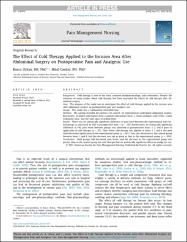The effect of cold therapy applied to the ıncision area after abdominal surgery on postoperative pain and analgesic use
Citation
Ozkan, B., Cavdar I., (2020) The Effect of Cold Therapy Applied to the Incision Area After Abdominal Surgery on Postoperative Pain and Analgesic Use. Pain Manag Nursing. s. 1524-9042. DOI: https://doi.org/10.1016/j.pmn.2021.03.007Abstract
Abstract
Background: Cold therapy is one of the most common nonpharmacologic pain treatments. Despite the existence of many studies about cold therapy, few have examined the effects of cold therapy after abdominal surgery.
Aims: The purpose of the study was to investigate the effect of cold therapy applied to the incision area after abdominal surgery on postoperative pain and analgesic use.
Design: This study was a randomized controlled trial METHODS: The sample included 60 patients (30 control, 30 experimental) undergoing abdominal surgery. Researchers recorded information from a patient information form, a visual analogue scale (VAS), a pain evaluation form, and the vital signs recording form.
Results: There was no statistically significant difference in pain level between the experimental and control groups as measured by VAS at postoperative hour 1 (p > .05). Furthermore, no statistically significant difference in VAS pain levels between groups was observed at postoperative hours 1, 2, and 8 prior to application of cold therapy (p > .05). Then, when cold therapy was applied at hours 1, 2 and 8, the pain level decreased significantly in the experimental group (p =.001). Pain also decreased in the control group between hours 1 and 8, but this decrease was not as great as that in the experimental group (p = .024).
Conclusions: Both groups had decreased pain levels, and the decrease in the experimental group was greater than in the control group but cold therapy had no statistically significant effect on analgesics use.


















